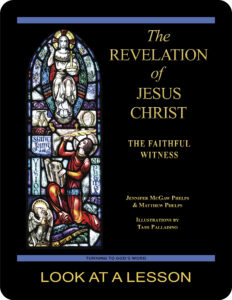 The Revelation of Jesus Christ:
The Revelation of Jesus Christ:
The Faithful Witness
Lesson 1 The Ruler of Kings on Earth
the book of Revelation 1:1–8
Revised Standard Version Catholic Edition (RSVCE)*
New American Bible Revised Edition (NABRE)*
Catechism of the Catholic Church
ex libris (in our library)
Aperuit Illis (Instituting the Sunday of the Word of God)
Ecclesia in Europa (The Church in Europe)
Tami Palladino’s visual-meditation journal
glossary for the book of Revelation
cross references in the book of Revelation
chapter-by-chapter review page
next lesson: Behold, I Am Alive For Evermore
This material coordinates with Lesson 1 on pages 4–10 in The Revelation of Jesus Christ: The Faithful Witness.
“Great and wonderful are your deeds, O Lord God the Almighty! Just and true are your ways,
O King of the ages! Who shall not fear and glorify your name, O Lord? For you alone are holy.
All nations shall come and worship you, for your judgments have been revealed.”
—the book of Revelation 15:3–4
welcome to our in-depth study of the book of Revelation
We invite groups and individuals to check out the sample first lesson and video from this 23-lesson Turning to God’s Word Catholic Bible study. Our online pages link
link  to the free lesson videos, a glossary, cross references in the biblical text, and a chapter-by-chapter review page—and they also include illustrations, maps, additional commentary, and prayers based on the primary Scripture in each lesson. The Revelation of Jesus Christ: The Faithful Witness has been granted an imprimatur. The study may be purchased from our website shop. If you have a Bible-related question or comment, click on the “ask us your question” or “what do you think” button on any study page.
to the free lesson videos, a glossary, cross references in the biblical text, and a chapter-by-chapter review page—and they also include illustrations, maps, additional commentary, and prayers based on the primary Scripture in each lesson. The Revelation of Jesus Christ: The Faithful Witness has been granted an imprimatur. The study may be purchased from our website shop. If you have a Bible-related question or comment, click on the “ask us your question” or “what do you think” button on any study page.
the second edition of this study has been granted an imprimatur
 The second edition of The Revelation of Jesus Christ: The Faithful Witness was
The second edition of The Revelation of Jesus Christ: The Faithful Witness was  granted an imprimatur by the Most Reverend William M. Joensen, Ph.D. (left), bishop of the Diocese of Des Moines, on August 10, 2022; the censor librorum for the Diocese of Des Moines, the Very Reverend Aquinas Nichols, granted the nihil obstat. The first edition was
granted an imprimatur by the Most Reverend William M. Joensen, Ph.D. (left), bishop of the Diocese of Des Moines, on August 10, 2022; the censor librorum for the Diocese of Des Moines, the Very Reverend Aquinas Nichols, granted the nihil obstat. The first edition was 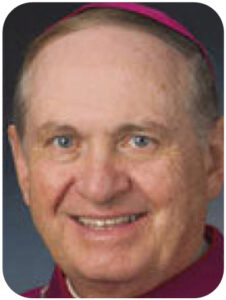 granted an imprimatur by the Most Reverend Richard E. Pates (right), bishop emeritus of the Diocese of Des Moines, on July 1, 2013. These are official declarations that a book or pamphlet is free of doctrinal or moral error. There’s no implication that those who’ve granted the imprimatur or nihil obstat agree with the contents, opinions, or statements expressed in the work. All Turning to God’s Word Catholic Bible studies are submitted to the Church before publication. Visit the archives of Lost in Translation to read more about the Latin terms imprimatur & nihil obstat. Turning to God’s Word Catholic Bible studies written after 2020 are being submitted to the Most Reverend William M. Joensen.
granted an imprimatur by the Most Reverend Richard E. Pates (right), bishop emeritus of the Diocese of Des Moines, on July 1, 2013. These are official declarations that a book or pamphlet is free of doctrinal or moral error. There’s no implication that those who’ve granted the imprimatur or nihil obstat agree with the contents, opinions, or statements expressed in the work. All Turning to God’s Word Catholic Bible studies are submitted to the Church before publication. Visit the archives of Lost in Translation to read more about the Latin terms imprimatur & nihil obstat. Turning to God’s Word Catholic Bible studies written after 2020 are being submitted to the Most Reverend William M. Joensen.
the popes inspire us—serious Catholics study the Word of God
In his apostolic letter Aperuit Illis (Instituting the Sunday of the Word of God) issued motu proprio (of his  own accord), Pope Francis established the Third Sunday in Ordinary Time to be devoted to the celebration, study, and dissemination of the Word of God. The Holy Father’s apostolic letter was published on September 30, 2019, the feast of St. Jerome and the 1600th anniversary of the saint’s death. St. Jerome, who translated the Latin
own accord), Pope Francis established the Third Sunday in Ordinary Time to be devoted to the celebration, study, and dissemination of the Word of God. The Holy Father’s apostolic letter was published on September 30, 2019, the feast of St. Jerome and the 1600th anniversary of the saint’s death. St. Jerome, who translated the Latin 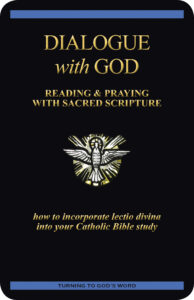 Vulgate Bible from Greek and Hebrew manuscripts, is famous for saying: “Ignorance of Scripture is ignorance of Christ.” In Aperuit Illis, the Holy Father calls attention to the sacramental nature of the Word of God, pointing to the unbreakable bond between Sacred Scripture and the Eucharist. In 2025, the Church will celebrate the Word of God on Sunday, January 26. We’ve posted a free digital version of Dialogue with God: Reading & Praying with Sacred Scripture, our guide to incorporating the Church’s traditional practice of lectio divina (sacred reading) into regular Bible study.
Vulgate Bible from Greek and Hebrew manuscripts, is famous for saying: “Ignorance of Scripture is ignorance of Christ.” In Aperuit Illis, the Holy Father calls attention to the sacramental nature of the Word of God, pointing to the unbreakable bond between Sacred Scripture and the Eucharist. In 2025, the Church will celebrate the Word of God on Sunday, January 26. We’ve posted a free digital version of Dialogue with God: Reading & Praying with Sacred Scripture, our guide to incorporating the Church’s traditional practice of lectio divina (sacred reading) into regular Bible study.
ex libris—read more Church documents
Find links to magisterial documents referred to in Turning to God’s Word Catholic Bible  studies, including Aperuit Illis (Instituting the Sunday of the Word of God), at ex libris—magisterial documents. The page lists significant recent encyclicals as well as a number of historical Church documents.
studies, including Aperuit Illis (Instituting the Sunday of the Word of God), at ex libris—magisterial documents. The page lists significant recent encyclicals as well as a number of historical Church documents.
a few reminders about Turning to God’s Word Bible studies
The most distinguishing feature of our Bible studies is that they’re Catholic. Each one has been granted an imprimatur, which means that a bishop has read the work and found nothing contrary to Church teaching on morals or faith. Note that the imprimatur makes no claim that a work is equivalent to Church teaching, simply that it isn’t opposed to what the Church teaches. Practically speaking, this means that you don’t have to accept Turning to God’s Word interpretations of Scripture, only that choosing to do so doesn’t amount to heresy. Choosing not to accept conclusions of a work that has been granted an imprimatur doesn’t immediately plunge you into heretical territory, but choosing not to accept Church teaching related to those conclusions does.
read the Catechism—how to avoid heresy
The imprimatur reinforces and validates the claim that Turning to God’s Word Bible studies are Catholic. All participants have a right to expect that discussions about our Bible studies will focus on Catholic teaching. That doesn’t mean that someone won’t occasionally have a question about Church teaching. Not knowing what the Church teaches about a particular issue isn’t heretical. Asking a question about Church teaching isn’t heretical. Failing to understand Church teaching isn’t heretical. Insisting that Church teaching is wrong is.
 Most people who begin to study the book of Revelation are caught off guard by how many challenging theological ideas are found in Scripture. There are a surprising number of things many Catholics believe to be Church teaching that actually are not. In this study, we attempt to present Scripture and Church teaching related to the book of Revelation as unambiguously as possible. When in doubt, you can refer to the Catechism of the Catholic Church or talk with your parish priest about any doctrine that remains unclear.
Most people who begin to study the book of Revelation are caught off guard by how many challenging theological ideas are found in Scripture. There are a surprising number of things many Catholics believe to be Church teaching that actually are not. In this study, we attempt to present Scripture and Church teaching related to the book of Revelation as unambiguously as possible. When in doubt, you can refer to the Catechism of the Catholic Church or talk with your parish priest about any doctrine that remains unclear.
If a Church teaching seems particularly unsettling even after studying the Catechism and speaking with someone who’s knowledgeable regarding Catholic doctrine, you might want to examine whether there might be a personal or emotional reason why you’re having difficulty. Pray for God’s guidance and be open to receiving a different answer than you anticipated, possibly at a later time than you expected or hoped.
be respectful of the others in your group
Keep in mind that most people in your discussion group are there for a Catholic interpretation of Scripture. People from other faith backgrounds are welcome, but the focus of any Turning to God’s Word study always is going to be Catholic in nature. The following opening prayer emphasizes maintaining mutual respect amid differences of opinion:
Heavenly Father, send forth your Spirit to enlighten our minds
and dispose our hearts to accept your truth.
Help us to listen to one another with openness and honesty,
eager to learn from the talents and intuitions that you have given each of us.
Never let differences of opinion diminish our mutual esteem and love.
May we leave this meeting with more knowledge and love for you and your Son.
In the unity of the Holy Spirit. Amen.
You can find other opening prayers on our website. We especially like the following:
Lord Jesus, you promised to send your Holy Spirit to teach us all things.
As we read and study your word today,
allow it to touch our hearts and change our lives. Amen.
our illustrations are intended to help in understanding difficult images
The book of Revelation is extremely visual, but it remains one of the most difficult books of the Bible to understand. Because the author is describing things that 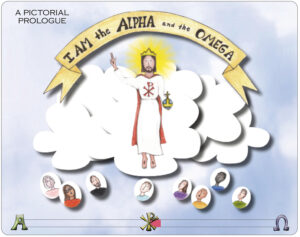 we don’t regularly encounter, it’s hard to imagine what these apocalyptic images might look like. To help, Turning to God’s Word has created illustrations to accompany each lesson of The Revelation of Jesus Christ: The Faithful Witness. These begin with a drawing co-founder Tami Palladino made to illustrate this lesson. It shows Jesus Christ as supreme ruler on Earth. Click on the image (right) to enlarge Tami’s illustration, which appears on page 7 in The Revelation of Jesus Christ: The Faithful Witness. Our illustrations will become more detailed as the subject matter becomes more complex. These aren’t intended as definitive views of heaven; they’re included to help us keep track of all the images in the book of Revelation.
we don’t regularly encounter, it’s hard to imagine what these apocalyptic images might look like. To help, Turning to God’s Word has created illustrations to accompany each lesson of The Revelation of Jesus Christ: The Faithful Witness. These begin with a drawing co-founder Tami Palladino made to illustrate this lesson. It shows Jesus Christ as supreme ruler on Earth. Click on the image (right) to enlarge Tami’s illustration, which appears on page 7 in The Revelation of Jesus Christ: The Faithful Witness. Our illustrations will become more detailed as the subject matter becomes more complex. These aren’t intended as definitive views of heaven; they’re included to help us keep track of all the images in the book of Revelation.
map notes—do you know the way to heaven?
This second edition of The Revelation of Jesus Christ: The Faithful Witness includes maps that show key geographical locations—although it’s impossible to map the location of heaven. The seven churches in Asia to which the author of the book of Revelation 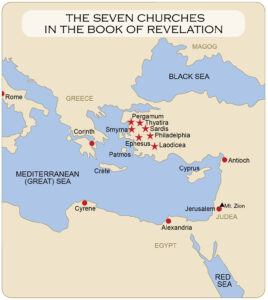 is writing aren’t named until the second lesson, but a map identifying them is included with this lesson. Readers should keep in mind that places shown on the map aren’t what’s most important in the final book of the New Testament. The author’s purpose is to describe heaven and encourage Christians to strive to go there. Heaven isn’t a location that can be plotted with geographical coordinates; when it comes to the spiritual life, Scripture and the Church offer the only reliable guidance about how to get to heaven. Click to enlarge the image of the map (right), which is on page 9 and elsewhere in the second and subsequent editions of The Revelation of Jesus Christ: The Faithful Witness.
is writing aren’t named until the second lesson, but a map identifying them is included with this lesson. Readers should keep in mind that places shown on the map aren’t what’s most important in the final book of the New Testament. The author’s purpose is to describe heaven and encourage Christians to strive to go there. Heaven isn’t a location that can be plotted with geographical coordinates; when it comes to the spiritual life, Scripture and the Church offer the only reliable guidance about how to get to heaven. Click to enlarge the image of the map (right), which is on page 9 and elsewhere in the second and subsequent editions of The Revelation of Jesus Christ: The Faithful Witness.
 core prophecy manifests at different times & places (01:02:06)
core prophecy manifests at different times & places (01:02:06)
Your initial reaction to the book of Revelation may well be, “Huh?”  In the video for this lesson, Turning to God’s Word author Matthew Phelps explains that one of the goals of this Turning to God’s Word Catholic Bible study is to make the text accessible. The book of Revelation stands in an existing threefold tradition of the Old Testament that consists of: 1) apocalyptic biblical literature—especially the Books of Ezekiel, Zechariah, and Daniel, 2) liturgical feasts and major historical events such as the Passover and the giving of the law, and 3) the prophets who came before Jesus. The images that Christians find so difficult to understand are based on images from the Old Testament.
In the video for this lesson, Turning to God’s Word author Matthew Phelps explains that one of the goals of this Turning to God’s Word Catholic Bible study is to make the text accessible. The book of Revelation stands in an existing threefold tradition of the Old Testament that consists of: 1) apocalyptic biblical literature—especially the Books of Ezekiel, Zechariah, and Daniel, 2) liturgical feasts and major historical events such as the Passover and the giving of the law, and 3) the prophets who came before Jesus. The images that Christians find so difficult to understand are based on images from the Old Testament. These images are developed in the book of Revelation to present a fuller picture of God. A major factor in our decision to expand this study was the insight we gained from writing our two-volume prophets study, Thus Says the LORD: God Speaks Through His Servants the Prophets—Volume I: A Kingdom Divided and —Volume II: Restoration & Redemption. The book of
These images are developed in the book of Revelation to present a fuller picture of God. A major factor in our decision to expand this study was the insight we gained from writing our two-volume prophets study, Thus Says the LORD: God Speaks Through His Servants the Prophets—Volume I: A Kingdom Divided and —Volume II: Restoration & Redemption. The book of  Revelation isn’t new, but rather is a re-presentation of previous prophecy. This final book of the New Testament looks at what happened from Creation through the
Revelation isn’t new, but rather is a re-presentation of previous prophecy. This final book of the New Testament looks at what happened from Creation through the  time of Jesus, and it challenges us to look at how events that happened then point toward what the Christian journey looks like now.
time of Jesus, and it challenges us to look at how events that happened then point toward what the Christian journey looks like now.
The Scripture ranges for the videos that accompany this Catholic Bible study match the Scripture ranges for the sets of questions in The Revelation of Jesus Christ: The Faithful Witness. You can follow along with the video overview as Turning to God’s Word author Matthew Phelps discusses Lesson 1, “The Ruler of Kings on Earth,” on pages 4–10 in the study book.
WHAT DO YOU THINK about interpreting Scripture?
 The Church encourages Catholics to read and interpret Scripture on our own as long as we follow these two rules:
The Church encourages Catholics to read and interpret Scripture on our own as long as we follow these two rules:
1) Our interpretation can’t contradict anything else in Scripture.
2) Our interpretation can’t contradict Church teaching.
In order to comply, we need to know everything else that’s in the Bible as well as everything that the Church teaches. That’s a tall order, which is why each Turning to God’s Word Catholic Bible study is submitted to the Church for an imprimatur. The imprimatur for The Revelation of Jesus Christ: The Faithful Witness is a guarantee that the Church finds nothing objectionable in the work. You’re free to agree with interpretations in this Catholic Bible study, but it’s not essential that you do so. There are many different interpretations in other commentaries, but few of them carry an imprimatur. This doesn’t mean that they necessarily pose any problems in regard to doctrine or morals, but there’s no Church guarantee that they don’t.
When considering opinions that haven’t been granted an imprimatur, don’t be afraid to ask questions. Our Bible studies address some common ideas, but there are innumerable opinions floating around about the meaning of different passages in the Bible—especially about the book of Revelation.
 ? Here’s the first question to ask about an opinion expressed in any commentary: How closely does it adhere to what we can read in the biblical text?
? Here’s the first question to ask about an opinion expressed in any commentary: How closely does it adhere to what we can read in the biblical text?
? Do viewpoints about the meaning of the Bible passages contradict anything else you already know from Scripture?
? Do they contradict anything from Church teaching? The Catechism of the Catholic Church addresses a large number of questions related to the most common Scripture interpretations.
get the name right for this last book of the Bible
An alarmingly large number of people have the idea that the name of the book we’re studying is “Revelations.” It isn’t. The title that the Revised Standard Version Catholic Editions (RSVCE and RSV2CE) use to refer to this book is The Revelation to John (The Apocalypse). All translations that use Revelation in the title of the last book of the New Testament use it in the singular. It’s fine to shorten that title and refer to the work simply as the book of Revelation, which we do throughout this study—but changing it to the plural and calling it “Revelations” is just flat wrong.
wild & crazy interpretations
When The Revelation of Jesus Christ: The Faithful Witness first was published in 2013, the Fox TV network was promoting a television show that tried to capitalize on people’s curiosity about the end times. In publicity for the show “Sleepy Hollow,” Fox claimed that the headless horseman in Washington Irving’s “The Legend of Sleepy Hollow” is the first of the four horsemen of the apocalypse from the book of Revelation. In promotions for the TV show, the Sleepy Hollow horseman was shown riding a white steed and wielding a long-handled axe. Fox described the show as “ridiculously entertaining.”
we concur about the ridiculous part
Anyone familiar with Scripture would have to agree the premise behind the show is ridiculous. This is just one way people distort images found in the book of Revelation. We’ll look at precisely what’s wrong with characterizing Irving’s headless horseman as one of the four horsemen described in the book of Revelation when we reach Lesson 7 And Behold, a White Horse. For now, it’s enough to say that many credible Scripture scholars view the first rider on the white horse as Jesus Christ, and that the biblical text specifies he’s carrying a bow, has been given a crown, and his mission is to go out “conquering and to conquer.” Even without considering whether the horseman in the book of Revelation represents Jesus, all of these things seem at odds with the picture that emerged from “Sleepy Hollow.” The TV character was riding a white horse, but any similarity to the book of Revelation ended there.
a cautionary word—beware of getting too imaginative
While the TV show may have had some entertainment value as an imaginative takeoff on Irving’s fiction, such riffs on Scripture always are dangerous. This is true whether they’re in the form of television shows or movies, predictions about the precise date of the end of the world, or any biblical commentary that veers from what the authors of Sacred Scripture actually wrote.
 Apocalypse—you could look it up in our archives
Apocalypse—you could look it up in our archives
Some translations include the word “Apocalypse” as part of the title of the book of Revelation. To learn the primary meaning of “apocalypse,” which has little to do with cataclysmic upheaval, read Lost in Translation, an online column in which Turning to God’s Word author Matthew Phelps helps readers connect with ideas expressed in the original languages of the Scriptures. New Lost in Translation entries are posted on Mondays, and past entries are archived on our website. Contact us if you’d like to receive Lost in Translation by email every week.
WHAT DO YOU THINK about the kingdom & priests?
It can be helpful to compare the kingdom and priests mentioned in the book of Revelation 1:6 with the  kingdom described in the book of Exodus 19:3–6. In mentioning a kingdom and priests, the author of the book of Revelation sets up liturgy as one of the key themes that will be developed as we move forward.
kingdom described in the book of Exodus 19:3–6. In mentioning a kingdom and priests, the author of the book of Revelation sets up liturgy as one of the key themes that will be developed as we move forward.
? Compare the Old Testament priesthood in the book of Exodus with the New Testament priesthood established by Jesus Christ. How are they the same, and how are they different?
 ? What condition does God place on the establishment of the kingdom in the book of Exodus 19:5?
? What condition does God place on the establishment of the kingdom in the book of Exodus 19:5?
? How’s that condition related to faith, and specifically to Jesus Christ as God’s faithful witness? (If necessary, refer to paragraphs 142 and 143 in the Catechism of the Catholic Church.)
? Consider whether the same condition that applies to the kingdom in the book of Exodus also applies to the kingdom referred to in the book of Revelation 1:6.
? In what ways do all Christians participate in the priesthood of Jesus Christ?
? How would you define the kingdom of which Jesus Christ rules?
? In what way does Jesus rule as king in your life?
the popes inspire us—we already know how the story will end
 When we read the book of Revelation, we’re peeking ahead in the Bible to learn the happy ending to the story of our salvation. “Final Victory” on page 10 in The Revelation of Jesus Christ: The Faithful Witness, is from Ecclesia in Europa (The Church in Europe). In it, Pope St. John Paul II
When we read the book of Revelation, we’re peeking ahead in the Bible to learn the happy ending to the story of our salvation. “Final Victory” on page 10 in The Revelation of Jesus Christ: The Faithful Witness, is from Ecclesia in Europa (The Church in Europe). In it, Pope St. John Paul II  explains that not only can we count on Jesus Christ to be victorious, the victory already has taken place. This is entirely in keeping with the idea that genuine prophecy is concerned with telling us something about God and not necessarily predicting specific future events. You can find links to other magisterial documents referred to in Turning to God’s Word Catholic Bible studies at ex libris—magisterial documents.
explains that not only can we count on Jesus Christ to be victorious, the victory already has taken place. This is entirely in keeping with the idea that genuine prophecy is concerned with telling us something about God and not necessarily predicting specific future events. You can find links to other magisterial documents referred to in Turning to God’s Word Catholic Bible studies at ex libris—magisterial documents.
will there be a final?
It’s not unusual to feel overwhelmed or intimidated at some point when studying the book of Revelation. When that happens, it’s important to remember that God’s Word is for everyone. Jesus didn’t come to earth to publish a doctoral thesis. As Christians we believe that the Bible is divinely inspired. Through the words of the Bible, God continues to speak anew and individually to each of us. When we study Scripture, there aren’t any pop quizzes. We don’t have to write a paper over what we’ve learned. There’s a final exam, however. Preparing for Final Judgment is what the book of Revelation is all about. If we want to do well, we need to be familiar with the text. That means reading it carefully and praying about what we’ve read in order to incorporate it into our lives as Christians.
Q&A—how the book of Revelation points to Old Testament prophecies
A participant in this Bible study questions whether translation differences are at play in the way that the book of Revelation 1:3 is interpreted.
Q: I’m wondering what you’re thinking about for the first question of Question 3. “What points to the idea that John is referring to the works of all the prophets?” By the way, I think the idea that this verse (the book of Revelation 1:3) is referring to all the prophets is really cool and something that wasn’t mentioned in the first version of this Turning to God’s Word study of the book of Revelation.
The Revised Standard Version Catholic translations (RSVCE and RSV2CE) both mention “the prophecy” in the book of Revelation 1:3, but all of the other Bibles on my shelf—including the New American Bible Revised Edition (NABRE) have “this prophecy.” It seems that the translation from the original Greek matters when answering this question, or is there some other clue that I’m missing in the biblical text?
A: [Here’s the question for the benefit of those who don’t have access to the study book. Question 3—Read the book of Revelation 1:3. What points to the idea that John is referring to the works of all of the prophets? How does the author suggest that readers approach this work? What does he promise those who do as he asks? What might be meant by the reference to the time being near? What is implied about the author’s role?]
 what Matthew says: “The Greek uses a definite pronoun (the) and not a demonstrative one (this), so the book of Revelation 1:3 appears to be talking about all biblical prophecy. I think I said as much at some length on the video for this lesson, but this isn’t the interpretation that most people expect when they read this verse.”
what Matthew says: “The Greek uses a definite pronoun (the) and not a demonstrative one (this), so the book of Revelation 1:3 appears to be talking about all biblical prophecy. I think I said as much at some length on the video for this lesson, but this isn’t the interpretation that most people expect when they read this verse.”
The video for this lesson does indeed address that the vision in the book of Revelation is based on what the author John already knows from Old Testament prophecy. As we move forward in our study it will become more and more obvious that John is re-viewing territory covered by the apocalyptic Old Testament  prophets (especially Isaiah, Ezekiel, Daniel, and Zechariah). The book of Revelation 1:3 contains the first indication of that. John “sees” this vision the same way that the Old Testament prophets “see” their visions of heaven, but John is looking at their works in the light of Christ. This means that the Old Testament prophecies are accurate but only describe a part of the picture. The Old Testament prophets did “see” what God wanted, but they and John are forced to use images to describe spiritual realities that are invisible to see
prophets (especially Isaiah, Ezekiel, Daniel, and Zechariah). The book of Revelation 1:3 contains the first indication of that. John “sees” this vision the same way that the Old Testament prophets “see” their visions of heaven, but John is looking at their works in the light of Christ. This means that the Old Testament prophecies are accurate but only describe a part of the picture. The Old Testament prophets did “see” what God wanted, but they and John are forced to use images to describe spiritual realities that are invisible to see with the human eye. What’s new in the book of Revelation is that John is explaining heaven from a Christian point of view, and that wasn’t an option available to the Old Testament prophets, who nevertheless still are describing what they’re able to “see” spiritually. The Turning to God’s Word two-
with the human eye. What’s new in the book of Revelation is that John is explaining heaven from a Christian point of view, and that wasn’t an option available to the Old Testament prophets, who nevertheless still are describing what they’re able to “see” spiritually. The Turning to God’s Word two- part Catholic Bible study, Thus Says the LORD: God Speaks Through His Servants the Prophets—Volume I: A Kingdom Divided and —Volume II: Restoration & Redemption provide an in-depth overview of the biblical prophets.
part Catholic Bible study, Thus Says the LORD: God Speaks Through His Servants the Prophets—Volume I: A Kingdom Divided and —Volume II: Restoration & Redemption provide an in-depth overview of the biblical prophets.
supplemental Scripture
As we press forward in our study of the book of Revelation, knowledge of content found in the book of Exodus will become increasingly helpful. Some people in previous study groups have used the summer months before starting The Revelation of Jesus Christ: The Faithful Witness to familiarize themselves with the book of Exodus. If you have the time and inclination, other books of the Bible we’d especially recommend reading in connection with study of the book of Revelation are the Old Testament prophets (particularly Daniel and Ezekiel), and in the New Testament the Letter to the Hebrews. You can learn more about the prophets in the Turning to God’s Word two-volume overview Thus Says the LORD: God Speaks Through His Servants the Prophets. Volume I: A Kingdom Divided covers biblical prophecy to the Babylonian Exile, and Volume II: Restoration & Redemption looks at the exilic and post-exilic prophets. You Shall Have No Other Gods: The Book of Exodus provides an in-depth study of the second book of the Old Testament. The Book of Joshua in the Old Testament would be another good choice, as would the Gospel According to John in the New Testament. You can learn more about the Fourth Gospel in our in-depth study The Gospel According to John: An Encounter with Grace & Truth.
months before starting The Revelation of Jesus Christ: The Faithful Witness to familiarize themselves with the book of Exodus. If you have the time and inclination, other books of the Bible we’d especially recommend reading in connection with study of the book of Revelation are the Old Testament prophets (particularly Daniel and Ezekiel), and in the New Testament the Letter to the Hebrews. You can learn more about the prophets in the Turning to God’s Word two-volume overview Thus Says the LORD: God Speaks Through His Servants the Prophets. Volume I: A Kingdom Divided covers biblical prophecy to the Babylonian Exile, and Volume II: Restoration & Redemption looks at the exilic and post-exilic prophets. You Shall Have No Other Gods: The Book of Exodus provides an in-depth study of the second book of the Old Testament. The Book of Joshua in the Old Testament would be another good choice, as would the Gospel According to John in the New Testament. You can learn more about the Fourth Gospel in our in-depth study The Gospel According to John: An Encounter with Grace & Truth.
related videos explain a few Jewish liturgical practices
The author of the book of Revelation is relying heavily on his audience’s knowledge of Hebrew and Jewish worship practices and Israel’s salvation history to build a foundation for understanding the Christian concept of the kingdom of heaven. The relationship between Old Testament liturgy and the book of Revelation was the topic of our 2017 summer Bible study retreat at Conception Abbey. YouTube videos of Turning to God’s Word author Matthew Phelps’ conference talks are embedded below. Links to all of Matthew’s previous conference talks can be found on our TtGW videos page.
Old Testament Liturgy in the Book of Revelation Part I (1:29:02)
Old Testament Liturgy in the Book of Revelation Part II (2:10:18)
Old Testament Liturgy in the Book of Revelation Part III (1:11:41)
another video—one that could change the way you approach the Bible (40:44)
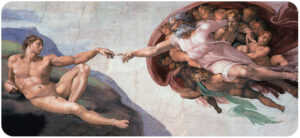 Even if you’re a veteran of Catholic Bible studies, we encourage you to watch an explanation of the practical benefits of approaching The Bible as the Living Word of God. This 40-minute video is distilled from a talk that Turning to God’s Word author Matthew Phelps gave at a summer Bible-study retreat at Conception Abbey in Conception, Missouri. In this video, Matthew looks at how viewing Scripture as a living document can help us to develop a more intimate relationship with Jesus Christ. There are real benefits in setting aside what we think we already know about Scripture to approach the Bible with the goal of learning what new things God is saying to us. Matthew examines the principles of lectio divina, the traditional Catholic approach to reading and praying with Scripture that’s foundational for all Turning to God’s Word Bible studies.
Even if you’re a veteran of Catholic Bible studies, we encourage you to watch an explanation of the practical benefits of approaching The Bible as the Living Word of God. This 40-minute video is distilled from a talk that Turning to God’s Word author Matthew Phelps gave at a summer Bible-study retreat at Conception Abbey in Conception, Missouri. In this video, Matthew looks at how viewing Scripture as a living document can help us to develop a more intimate relationship with Jesus Christ. There are real benefits in setting aside what we think we already know about Scripture to approach the Bible with the goal of learning what new things God is saying to us. Matthew examines the principles of lectio divina, the traditional Catholic approach to reading and praying with Scripture that’s foundational for all Turning to God’s Word Bible studies.
Comforting Mysteries of the Rosary
In German-speaking countries, it’s not unusual to see reference to a fifth set of Mysteries of the Rosary, usually referred to as the Comforting Mysteries. Although these aren’t considered to be on the same level as the Joyful, Sorrowful, Glorious, and Luminous Mysteries, Catholics in those countries nevertheless are encouraged to pray the Comforting Mysteries in private. Because these mysteries are closely tied to important themes in the book of Revelation, we’ll occasionally be mentioning them in passing as a matter of interest. The Comforting Mysteries are:
Jesus who reigns as king
Jesus who lives and acts in his Church
Jesus who will return in glory
Jesus who will judge the living and the dead
Jesus who will complete everything
 The connection to the first lesson in our study of The Revelation of Jesus Christ: The Faithful Witness is apparent in the lesson title—”The Ruler of Kings on Earth.” Watch for more references to Jesus as king as we move forward in our study. In future lessons, we’ll also encounter evidence of the other four Comforting Mysteries of the Rosary. You can learn more about the traditional
The connection to the first lesson in our study of The Revelation of Jesus Christ: The Faithful Witness is apparent in the lesson title—”The Ruler of Kings on Earth.” Watch for more references to Jesus as king as we move forward in our study. In future lessons, we’ll also encounter evidence of the other four Comforting Mysteries of the Rosary. You can learn more about the traditional  Mysteries of the Rosary in Scripture & the Rosary: New Testament Mysteries, Old Testament Parallels. Free digital lessons from that Bible study are available on our website on a rotating basis throughout the liturgical year.
Mysteries of the Rosary in Scripture & the Rosary: New Testament Mysteries, Old Testament Parallels. Free digital lessons from that Bible study are available on our website on a rotating basis throughout the liturgical year.
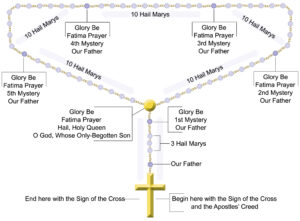 pray the traditional mysteries of the Rosary
pray the traditional mysteries of the Rosary
We invite you to pray the Rosary along with Turning to God’s Word co-founder Tami Palladino and her daughter Anne Marie. The prayers can be found at how to pray the Rosary, along with Tami and Anne Marie’s videos of each of the traditional Rosary Mysteries—the Joyful, Sorrowful, Glorious, and Luminous. Click on the diagram (right) to link to their how-to video. Visit the study directory of our most popular Catholic Bible study, Scripture & the Rosary: New Testament Mysteries, Old Testament Parallels, for more information about the Rosary and access to free online lessons.
visual meditation as a form of prayer
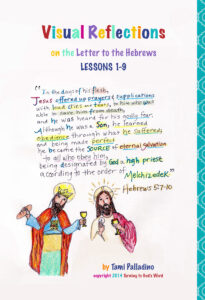 If you like to draw, consider illustrating your prayers for The Revelation of Jesus Christ: The Faithful Witness. For inspiration, check out the
If you like to draw, consider illustrating your prayers for The Revelation of Jesus Christ: The Faithful Witness. For inspiration, check out the  drawings in this study and in the visual-meditation journal, which Turning to God’s Word co-founder Tami Palladino created to accompany another of our Catholic Bible studies—The Letter to the Hebrews: An Explanation of the Mechanism of Our Salvation. Tami also illustrated Sing a New Psalm: Communicating with God Through the Prayers of the Church—Volume I: Lauds & Vespers and lessons in In the Beginning: The Book of Genesis and You Shall Have No Other Gods: The Book of Exodus.
drawings in this study and in the visual-meditation journal, which Turning to God’s Word co-founder Tami Palladino created to accompany another of our Catholic Bible studies—The Letter to the Hebrews: An Explanation of the Mechanism of Our Salvation. Tami also illustrated Sing a New Psalm: Communicating with God Through the Prayers of the Church—Volume I: Lauds & Vespers and lessons in In the Beginning: The Book of Genesis and You Shall Have No Other Gods: The Book of Exodus.
Q&A—where to find some answers
Some people are used to doing Bible studies from other publishers, and they’ve told us that they miss the answer keys that many of those studies offer. One leader even admitted that she relied on answer keys so she didn’t have to spend time doing Bible study lessons herself. We sympathize with omnipresent time constraints, but we maintain that up-front answer keys provide people with a strong temptation to rely on someone else’s idea of what Scripture means instead of thinking more deeply about what God might be trying to say to each of us as individuals at a particular moment in time.
 Q: Why don’t Turning to God’s Word Catholic Bible studies provide any printed answer keys?
Q: Why don’t Turning to God’s Word Catholic Bible studies provide any printed answer keys?
A: The Turning to God’s Word method of Bible study is dependent on participants directly engaging with the biblical text and looking to that text for answers to their questions. All of the factual questions in the lessons can be answered from the Scriptures. Sidebars in the lessons contain supplemental material written to help explain some of the themes suggested by the biblical text. Most of our studies, including this one, feature videos with each lesson. We encourage participants to watch these videos, which contain some of our most interesting theological ideas.
Outside commentaries can shed light on individual texts, but many commentaries examine Scripture passages out of context. Some may focus on an academic rather than a spiritual approach to the Bible. If you’re confused about anything in our studies or in any related outside commentaries, we encourage you to browse our website for more information.
The goal of all Turning to God’s Word Catholic Bible studies is to foster personal reflection leading to a more intimate relationship with Jesus. Consequently, each lesson contains  reflection questions, and these necessarily don’t have any “right” or “wrong” answers. If you’d like to share your thoughts about any of our studies or need clarification about a question, commentary, or video related to the lessons, contact us using the “ask us your question” or “what do you think” button on any online lesson page. Because others may have the same concern, we routinely turn questions and comments we receive into anonymous Q&A items and add them to the relevant online study pages.
reflection questions, and these necessarily don’t have any “right” or “wrong” answers. If you’d like to share your thoughts about any of our studies or need clarification about a question, commentary, or video related to the lessons, contact us using the “ask us your question” or “what do you think” button on any online lesson page. Because others may have the same concern, we routinely turn questions and comments we receive into anonymous Q&A items and add them to the relevant online study pages.
Q&A—three questions about Bible translations
We’re frequently asked what translation of the Bible is best. Sometimes we’re asked which translation is approved to be read at Catholic Masses. More infrequently we’re asked why we’ve chosen to reprint the Revised Standard Version Second Catholic Edition (RSV2CE) for the biblical text in our printed studies.
Q1: Which translation of the Bible is the best one for Catholics to read? 
A2: As far as which translation is best, we maintain that reading any translation of the Bible you have on hand is a great place to start. The old adage “every translator is a traitor” certainly applies to Scripture, but God’s basic message to his people can be found in any Bible. While there are English-language Bibles catering to a variety of special-interest Catholic groups, they generally reprint either a translation of the New American Bible Revised Edition (the NABRE) or a Catholic edition of the Revised Standard Version (the RSVCE or the RSV2CE), which are the Bibles read by most American Catholics. Both of these translations rely on archeological finds and scholarship that were unavailable in earlier centuries. Before the mid-1960s, many Catholics were familiar with the Douay-Rheims English translation, which was based on the Latin Vulgate. Originally translated by St. Jerome in the late 4th century, a version of the Vulgate has remained the official Latin translation of the Catholic Church since the 16th century. Before the mid-1960s, most Protestants read The King James Version.
As people become more interested in Scripture study, they also become more interested in reading the “right” Bible. Since very few of us are proficient in ancient languages, we’re forced to rely on the work of scholars who’ve spent years studying Hebrew, Greek, Aramaic, and Latin. In many cases, there simply isn’t an easy way to translate some of the original words and phrases of Scripture into English. The best advice we can offer is to choose an English translation that the Church has approved. The United States Conference of Catholic  Bishops (USCCB) offers guidelines. When questions arise, as they undoubtedly will, check out footnotes, commentaries, and other translations; talk to a knowledgeable priest; and—this part is most important—ask God to grant you increased understanding. You also can email us with your questions about Scripture. In many cases, Turning to God’s Word author Matthew Phelps’ background in classical languages proves helpful. We frequently rely on him to shed some light on the linguistics involved in difficult passages.
Bishops (USCCB) offers guidelines. When questions arise, as they undoubtedly will, check out footnotes, commentaries, and other translations; talk to a knowledgeable priest; and—this part is most important—ask God to grant you increased understanding. You also can email us with your questions about Scripture. In many cases, Turning to God’s Word author Matthew Phelps’ background in classical languages proves helpful. We frequently rely on him to shed some light on the linguistics involved in difficult passages.
Q2: I’m having trouble locating the same Bible that I hear read at Mass. What translation is that?
A2: The Catholic Lectionary, a collection of biblical texts approved for liturgical use, isn’t the same as a Bible. The English-language lectionary used in the United States is primarily based on a 1970 translation. A close English translation outside the lectionary is the New American Bible Revised Edition (NABRE). The United States Conference of Catholic Bishops (USCCB) currently is working on a new liturgical Bible based on the NABRE.
 Q3: Why has Turning to God’s Word chosen to reprint biblical text from the Revised Standard Version Second Catholic Edition (RSV2CE) instead of the New American Bible Revised Edition (NABRE)?
Q3: Why has Turning to God’s Word chosen to reprint biblical text from the Revised Standard Version Second Catholic Edition (RSV2CE) instead of the New American Bible Revised Edition (NABRE)?
A3: We currently use the Revised Standard Version Second Catholic Edition (RSV2CE) as our primary biblical translation in our printed studies because scholars consider it to be a more faithful word-for-word translation than many other translations. Pope Benedict XVI quotes from the RSV2CE in his three-volume book, Jesus of Nazareth. The RSVCE is the Bible translation used in English translations of the Catechism of the Catholic Church. The RSV2CE varies only slightly from the earlier RSVCE, which we link to on our online study pages. Any discrepancies between the RSV2CE and the RSVCE are pointed out on the online study pages. Turning to God’s Word cites The Abbey Psalms and Canticles in references to the Psalms in all of our printed studies.
pray with the Psalms—intensely emotional prayers
Although some scholars question David’s authorship of the Psalms, it remains indisputable that many of the Psalms address  themes related to events that occurred during the period when David ruled over the descendants of Jacob. Reading and praying with the Psalms offers insight into the minds and hearts of people who lived during the time of David—and who lived long afterward as well. These prayers express universal human feelings every bit as relevant to us in the present day as when the Psalms first were composed.
themes related to events that occurred during the period when David ruled over the descendants of Jacob. Reading and praying with the Psalms offers insight into the minds and hearts of people who lived during the time of David—and who lived long afterward as well. These prayers express universal human feelings every bit as relevant to us in the present day as when the Psalms first were composed.
don’t get confused—Psalms numbering varies
Numbering of many Psalms and their verses varies from one translation to another. Parallel  numbering for commonly used Catholic Bibles is noted in the citations index included in the sample lesson for our study of the book of Revelation. For more information about why the numbering varies in some translations, see the online Q&A on the study page for Lesson 1 Set a Guard on My Mouth in the Turning To God’s Word Catholic Bible study Sing a New Psalm: Communicating with God Through the Prayers of the Church—Volume I: Lauds & Vespers.
numbering for commonly used Catholic Bibles is noted in the citations index included in the sample lesson for our study of the book of Revelation. For more information about why the numbering varies in some translations, see the online Q&A on the study page for Lesson 1 Set a Guard on My Mouth in the Turning To God’s Word Catholic Bible study Sing a New Psalm: Communicating with God Through the Prayers of the Church—Volume I: Lauds & Vespers.
the best Catholic commentary about Scripture
 To find out more about how Church teaching is supported by Scripture passages in The Revelation of Jesus Christ: The Faithful Witness, check out the Index of Citations in the Catechism of the Catholic Church. Links to the primary Scripture passages in the lesson (Revised Standard Version Catholic Edition [RSVCE*]) and relevant paragraphs in the Catechism are provided here. Not every passage in the biblical text for this Catholic Bible study is referenced in a Catechism paragraph, however.
To find out more about how Church teaching is supported by Scripture passages in The Revelation of Jesus Christ: The Faithful Witness, check out the Index of Citations in the Catechism of the Catholic Church. Links to the primary Scripture passages in the lesson (Revised Standard Version Catholic Edition [RSVCE*]) and relevant paragraphs in the Catechism are provided here. Not every passage in the biblical text for this Catholic Bible study is referenced in a Catechism paragraph, however.
the book of Revelation 1:4—paragraphs 1403, 2854
the book of Revelation 1:6—paragraphs 1546, 2855
the book of Revelation 1:8—paragraph 2854
ways our glossary might prove helpful
In addition to providing extra information about geographical locations, our glossary also points out persons and places mentioned in the biblical text under multiple names or spellings. If you can remember a name but aren’t sure in which lesson it shows up, you can find it in the glossary, which lists every proper noun in the primary biblical text for The Revelation of Jesus Christ: The Faithful Witness.
persons and places mentioned in the biblical text under multiple names or spellings. If you can remember a name but aren’t sure in which lesson it shows up, you can find it in the glossary, which lists every proper noun in the primary biblical text for The Revelation of Jesus Christ: The Faithful Witness.
to learn more, read more Scripture
If you’re having difficulty with a passage of Scripture, it can be helpful to read the  cross references pertaining to it—but looking these up can take time. To make that easier, we’ve compiled the cross references from the Revised Standard Version Second Catholic Edition (RSV2CE)—the translation that we reprint in our study books. That list can be found at the top of every online study page, and it includes links to cross references in the primary biblical text for The Revelation of Jesus Christ: The Faithful Witness.
cross references pertaining to it—but looking these up can take time. To make that easier, we’ve compiled the cross references from the Revised Standard Version Second Catholic Edition (RSV2CE)—the translation that we reprint in our study books. That list can be found at the top of every online study page, and it includes links to cross references in the primary biblical text for The Revelation of Jesus Christ: The Faithful Witness.
review previous lessons
As we progress through the book of Revelation, the images become more complex, increasing the potential for confusion. To help participants  in our study keep track of what’s happening in the Scripture, we’ve prepared a chapter-by-chapter review of key events and images in the book of Revelation. A link can be found at the top of every online study page that accompanies The Revelation of Jesus Christ: The Faithful Witness.
in our study keep track of what’s happening in the Scripture, we’ve prepared a chapter-by-chapter review of key events and images in the book of Revelation. A link can be found at the top of every online study page that accompanies The Revelation of Jesus Christ: The Faithful Witness.
don’t forget about our indexes & extra online material

 If you’re trying to locate information about a specific Scripture passage, you can look it up in the index at the back of the study book or sample lesson. If you want to find a particular commentary, you can look up its title in the topics index. To learn more about another book of the Bible for which there’s a Turning to God’s Word study, visit the online study directories to read the commentaries and watch any accompanying videos. Finally, if you have a question or would like to make a comment about any of our studies, you can use one of the “ask us your question” or “what do you think” buttons to email our authors.
If you’re trying to locate information about a specific Scripture passage, you can look it up in the index at the back of the study book or sample lesson. If you want to find a particular commentary, you can look up its title in the topics index. To learn more about another book of the Bible for which there’s a Turning to God’s Word study, visit the online study directories to read the commentaries and watch any accompanying videos. Finally, if you have a question or would like to make a comment about any of our studies, you can use one of the “ask us your question” or “what do you think” buttons to email our authors.
ex libris—Church documents & books about religious topics
Link to magisterial documents referred to in our Bible studies at ex libris—magisterial documents.  This listing includes significant recent encyclicals as well as a number of historical Church documents. Recommended books related to Scripture study can be found at ex libris—main bookshelf.
This listing includes significant recent encyclicals as well as a number of historical Church documents. Recommended books related to Scripture study can be found at ex libris—main bookshelf.
memorize a favorite Bible verse (4:46)
Turning to God’s Word co-founder Tami Palladino has created a short video about the benefits of memorizing Bible verses. Choosing a passage that you find particularly meaningful will make the task easier. There are inspiring verses in every book of the Bible, and some people in our Turning to God’s Word Catholic Bible studies like to memorize a verse from their lesson every week. For more ideas, check out Tami’s video, Why Memorize Scripture? It’s less than five minutes long.
wondering how to pronounce some of these words?
The following link is to a reading from the New International Version (NIV) Bible. To listen, click on the audio icon above the printed text. Although not taken from the translations used in our study materials, the NIV reading provides an audio guide to pronunciation of words in this lesson’s primary biblical text. A close online version of the translation of the Bible used in Catholic liturgy in the United States as well as an audio guide for daily Mass readings for the current month can be found on the website of the United States Conference of Catholic Bishops (USCCB).
the book of Revelation 1:1–8 (NIV)
 close with Bible-based prayer related to this lesson
close with Bible-based prayer related to this lesson
Many of our Catholic study groups like to conclude their discussions with a prayer based on the scriptural focus of their lesson, and some participants include Scripture-specific prayer in their individual study. If you’re uncomfortable composing your own Bible-based prayers, you can follow our four easy steps. If you prefer, you can use the following short prayer based on this lesson’s text from the book of Revelation.
O God, you who were and are and are to come,
grant that as we aspire to greater understanding
about the end of time we also may aspire
to use wisely and in a way pleasing to you
the remaining time given to us on earth.
We ask this in the name of Jesus Christ,
who always has been, is now, and always will be your faithful witness. Amen.
Lesson 2 Behold, I Am Alive For Evermore—the book of Revelation 1:9–20
you also may like our study of the book of Genesis
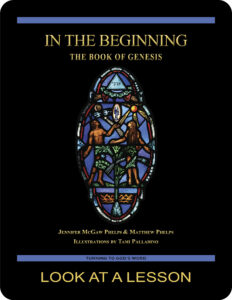 The first seven lessons of In the Beginning: The Book of Genesis, a 28-lesson Catholic Bible study with an imprimatur, provide an in-depth look at the very earliest biblical history—including the two accounts of Creation, events surrounding the Fall of Adam and Eve, the relationship between Cain and Abel, and the baptismal foreshadowing present in the account of Noah and the Flood. Remaining lessons look at lives of the patriarchs Abraham, Isaac, Jacob, and Joseph. Click on the book’s cover to view a sample lesson.
The first seven lessons of In the Beginning: The Book of Genesis, a 28-lesson Catholic Bible study with an imprimatur, provide an in-depth look at the very earliest biblical history—including the two accounts of Creation, events surrounding the Fall of Adam and Eve, the relationship between Cain and Abel, and the baptismal foreshadowing present in the account of Noah and the Flood. Remaining lessons look at lives of the patriarchs Abraham, Isaac, Jacob, and Joseph. Click on the book’s cover to view a sample lesson.
start a Turning to God’s Word Bible study
 Thank you for your interest in The Revelation of Jesus Christ: The Faithful Witness.
Thank you for your interest in The Revelation of Jesus Christ: The Faithful Witness.  Information about beginning a Turning to God’s Word Bible study can be found at start a Bible study. Tami, Matthew, and I are available to answer questions and offer support. Contact us if you’d like to start one of our studies or have your schedule listed with other TtGW study groups on our website. —Jennifer
Information about beginning a Turning to God’s Word Bible study can be found at start a Bible study. Tami, Matthew, and I are available to answer questions and offer support. Contact us if you’d like to start one of our studies or have your schedule listed with other TtGW study groups on our website. —Jennifer
*There are seven deuterocanonical books in the Old Testament—the Books of Tobit, Judith, Wisdom, Sirach, Baruch, and First and Second Maccabees, as well as some passages in the Books of Esther and Daniel. Protestants usually refer to these works as “apocryphal,” a word that means “outside the (Protestant) canon” because they’re excluded from most Protestant Bibles. The word “deuterocanonical” means “second canon”; Catholics use that word to refer to any section of the Catholic Old Testament for which there are no extant, or existing, Hebrew manuscripts. All of the deuterocanonical books appear in the Septuagint, the earliest remaining versions of which date to the 1st century B.C. This Greek translation of the Old Testament was in common use by Jews at the time of Jesus. Learn more by reading How Do Catholic & Protestant Bibles Differ?
Turning to God’s Word printed Bible studies use the 2006 Revised Standard Version Second Catholic Edition (RSV2CE) translation for all Scripture references except those to the Psalms, which are taken from The Abbey Psalms and Canticles, prepared by the Benedictine monks of Conception Abbey and published in 2020 by the United States Conference of Catholic Bishops (USCCB). All Scripture links for the online pages of The Revelation of Jesus Christ: The Faithful Witness are to the 1966 Revised Standard Version Catholic Edition (RSVCE) translation. The New International Version (NIV) audio recordings follow the same chapter and verse numbering as the RSV Catholic translations, but the NIV translation doesn’t include the deuterocanonical books and passages.
The 1966 RSVCE uses archaic pronouns and verb forms such as “thee,” “thou,” “didst” in the Psalms and in direct quotations attributed to God. The 2006 RSV2CE replaces these with more accessible English. The few significant translation changes in the RSV2CE include rendering almah as “virgin” in the Book of Isaiah 7:14 and restoring the term “begotten” in the Gospel According to John 3:16.
Numbering varies for some passages in this Bible study. Turning to God’s Word studies (print and digital) follow the numbering in the Revised Standard Version Catholic translations (RSV2CE and RSVCE). Discrepancies in the New American Bible Revised Edition (NABRE) are noted in the Index of Scripture Citations in the study book and the online sample.
 You can learn more about the Psalms by viewing a sample lesson from the Turning to God’s Word Catholic Bible study Sing a New Psalm: Communicating with God Through the Prayers of the Church—Volume I: Lauds & Vespers. The second part of that study, Sing a New Psalm: Communicating with God Through the Prayers of the Church—Volume II: Vigils, Day Prayer & Compline, is scheduled for publication in 2025. Some verse numbers may vary in different translations of the Psalms.
You can learn more about the Psalms by viewing a sample lesson from the Turning to God’s Word Catholic Bible study Sing a New Psalm: Communicating with God Through the Prayers of the Church—Volume I: Lauds & Vespers. The second part of that study, Sing a New Psalm: Communicating with God Through the Prayers of the Church—Volume II: Vigils, Day Prayer & Compline, is scheduled for publication in 2025. Some verse numbers may vary in different translations of the Psalms.
